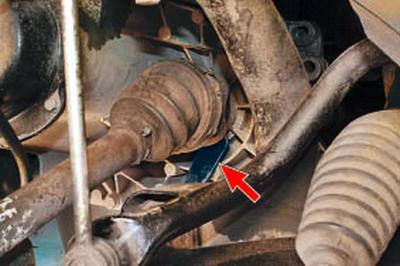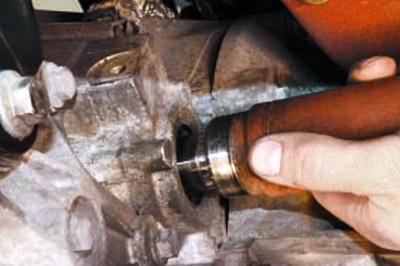NOTE: Left and right front wheel drives are different in design (the right front wheel drive is made in one piece with the intermediate shaft), therefore, the left and right drives are removed partially by different methods, described separately for each drive.
You will need: all tools for removing the engine crankcase (see Removal and installation of mudguard and crankcase protection), disconnecting the ball joint from the steering knuckle (see Ball joint replacement), tie rod from swing arm (refer to Outer Tie Rod End Replacement), as well as a socket head and a key "for 13", a wrench for wheel nuts.
To remove the left front wheel drive, perform the following operations.
1. Remove the crankcase protection (see Removal and installation of mudguard and crankcase protection).
2. Drain the oil (working fluid) from the gearbox (see Manual Transmission Oil Change or Automatic Transmission Fluid Change).
3. Remove the decorative cap of the left front wheel, if any.

4. Loosen the hub bolt and wheel nuts.
NOTE: If the vehicle is fitted with light alloy wheels, remove the wheel as the hub covers the vehicle's hub bolt.
WARNING: Loosen and tighten the wheel nuts only with the vehicle on the ground.
5. Brake the vehicle with the parking brake, place chocks under the rear wheels and raise the front of the vehicle to secure stands.
6. Remove a forward wheel if a wheel with a stamped disk and it has not been removed previously.

7. Turn out a bolt of a nave and remove it together with a persistent washer.

8. Disconnect the left tie rod from the swing arm (refer to Outer Tie Rod End Replacement).

9. Turn away a nut of a finger of a spherical support and press out a finger a stripper (see Ball joint replacement).

10. Slightly move the shock absorber strut aside and remove the shank of the external constant velocity joint from the hub.
NOTE: Front brake caliper removed for clarity. When removing the front wheel drive, it is not required to remove it.

USEFUL ADVICE: If you cannot remove the pivot shank with your hands, knock it out of the hub with light hammer blows through a soft metal drift.
WARNING: Be careful not to protrude the drive shaft from the inboard joint housing as this may damage the joint.

11. Having rested the mounting blade in the gearbox housing..

12.... press the inner joint of the drive from the side gear and remove the left front wheel drive assembly.
NOTE: The gap between the inboard joint housing and the gearbox housing is very small and it is not possible to insert the end of the spudger all the way into it all at once. After inserting the pointed part of the mounting blade into the gap, with gentle hammer blows along the blade, drive its end deep into the gap and move the hinge body away from the crankcase with it like a wedge until the retaining ring of the hinge shank comes out of the axle shaft gear. Then finally push the hinge shank out of the gear with a spatula.
WARNING: When using a spudger when pressing the inner joint out of the gear of the half shaft of the transmission, be careful not to damage the gearbox housing and the joint.

Replace the inner joint shank retaining ring with a new one each time the actuator is removed from the vehicle.
13. To install the drive, first insert the splined shank of the outer joint housing into the wheel hub, install the thrust washer and screw in the hub bolt until it stops without fully tightening it.
14. Then insert the splined shank of the inner joint housing into the axle shaft seal and turn the drive shaft slightly so that the splines of the joint shank and the axle gear are aligned.
15. Pull down the front suspension arm and with a sharp movement of the shock absorber strut with a steering knuckle, press the drive into the axle shaft gear until the drive is fixed with the retaining ring.
16. With a sharp jerk at the steering knuckle, try to pull the shank of the inner joint from the side gear. If this succeeds, repeat the installation of the hinge into the gear. If a second attempt does not produce the desired result, replace the inner joint shank retaining ring.
17. After installing all the parts, fill in the oil (working fluid) into the gearbox (see Manual Transmission Oil Change or Automatic Transmission Fluid Change).
18. Install the wheel (if its disk is stamped) and tighten the wheel nuts to the stop, without tightening them completely.
19. Install the car on the wheels, removing it from the supports, and tighten the hub bolt.
WARNING: Final tighten the hub bolt with the vehicle on the ground to 35 Nm (3.5 kgf·m) and then turn 90°. It is strictly forbidden to move the car with the hub bolt loose in order to avoid damage to the hub bearing separator.
NOTE: If the vehicle is fitted with alloy wheels, the hub bolt will need to be tightened prior to installing the wheel on the lifted vehicle. To prevent the hub from turning, engage first gear in the gearbox and have an assistant depress the brake pedal and hold it in this position.
20. Tighten the wheel nuts.
To remove the right front wheel drive, perform the following operations.
1. On the right side of the vehicle, perform steps 1-10 that were performed on the left side to remove the left front wheel drive (see XXXXXXXXXXXX above).

2. Turn away two nuts of fastening of bracket of an intermediate support..

3….and remove the bracket.

4. Remove the inner joint shank from the side gear..

5.... and remove the right front wheel drive assembly.

NOTE: If necessary, remove the three bolts securing the intermediate support bracket to the engine block..

... and remove the bracket.
6. To install the drive, first insert the splined shank of the outer joint housing into the wheel hub, install the thrust washer, and screw in the hub bolt until it stops without fully tightening it.
7. Then insert the splined shank of the internal hinge housing into the axle shaft seal and turn the drive shaft slightly so that the splines of the hinge shank and the axle gear coincide, then by moving the shock absorber strut with the steering knuckle, enter the drive into the axle gear until it stops.
8. Install and nut the intermediate support bracket.
9. After installing all parts, fill with oil (liquid) into the gearbox (see Manual Transmission Oil Change or Automatic Transmission Fluid Change).
10. Establish a wheel and wrap nuts of its fastening against the stop, without tightening finally.
11. Install the car on the wheels, removing it from the supports, and tighten the hub bolt.
WARNING: Final tighten the hub bolt with the vehicle on the ground to 35 Nm (3.5 kgf·m) and then turn 90°. It is strictly forbidden to move the car with the hub bolt loose in order to avoid damage to the hub bearing separator.
12. Tighten the wheel nuts.
Visitor comments